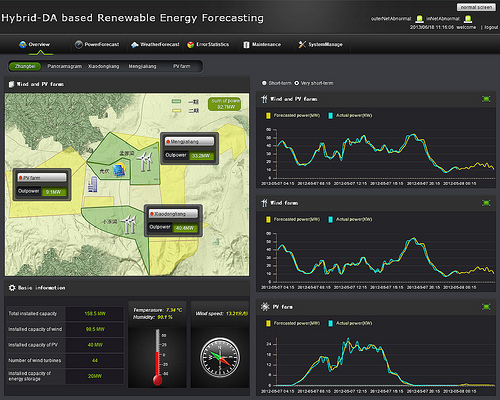
Predictive Analytics Prevailing on the Wind Farm
The interaction between electricity grid operators and generators of renewable energy is not always a smooth one. Poor foresight into renewable energy capacity leads grid operators to order more energy from conventional sources, which keeps the lights on but increases pollution. IBM is addressing this prediction gap with a new big data solution called Hybrid Renewable Energy Forecasting, or HyRef.
 HyRef uses a combination of weather forecasts, sensor data, and big data analytics to provide a more accurate forecast of the availability of wind power and solar energy, in time increments ranging from five minutes to one month. This approach should help grid operators make better use of the available renewable energy, and help reduce carbon emissions, IBM says.
HyRef uses a combination of weather forecasts, sensor data, and big data analytics to provide a more accurate forecast of the availability of wind power and solar energy, in time increments ranging from five minutes to one month. This approach should help grid operators make better use of the available renewable energy, and help reduce carbon emissions, IBM says.
“The industry around the world is looking for the right kind of tools and techniques to be able to inject large amounts of wind and solar into the network reliably,” said Brad Gammons, general manager of IBM’s Global Energy & Energy Utilities Industry segment. The new HyRef solution “allows us to gain insights and predictive ability over how much power is available at a given time to put into the network.”
According to IBM, 20 to 40 percent of renewable energy cannot be used because it’s unstable. “It’s not controllable,” says Meng Zhang, a research scientist in IBM Research China. “We can help the renewable power generation company to provide the accurate prediction of renewable power output.”
That could have a big impact on a city like Beijing, which has a horrible pollution problem. According to IBM, a 10 to 30 percent increase in the use of wind-based energy could mean the difference between sunshine and smog.
HyRef is already being put to use on the Chinese national grid. The 216-megawatt Zhangbei National Energy Storage and Transmission Demonstration Project includes wind, solar, and lithium ion battery storage components, to go along with a smart distribution system. It’s using HyRef to forecast wind, with the hopes of increasing energy from wind by 10 percent, which is enough to power 14,000 homes, IBM says.
HyRef builds on two other IBM projects, including a collaboration in Denmark with wind power turbine manufacturer Vestas Wind Systems, in which big data analytics and supercomputer resources combined to optimize the placement of windmills to boost power output and lower operational costs; and the Deep Thunder project, in which IBM developed high-resolution, micro-forecasts for weather in a particular region.
Related items:
The Big Data Weather Watchers in the Sky
Weathering Risk Management Data






























